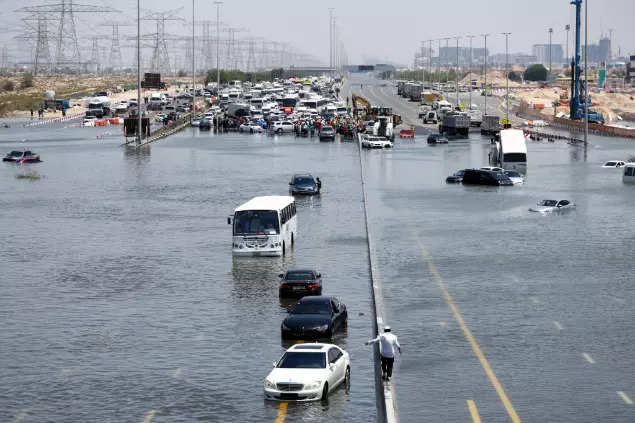A storm hit the UAE and Oman this week bringing record rainfall that flooded highways, inundated houses, gridlocked traffic and trapped people in their homes.
At least 20 people were reported to have died in the deluge in Oman while another person was said to have died in floods in the UAE that closed government offices and schools for days.
Watch: Dubai drowns after record rainfall medium nocaption109376418
The storm had initially hit Oman on April 14 before it pounded the UAE on April 16, knocking out power and causing huge disruptions to flights as runways were turned into rivers.
In the UAE, a record 254mm of rainfall was recorded in Al Ain, a city bordering Oman. It was the largest ever in a 24-hour period since records started in 1949.
Did cloud seeding cause the storm?
Rainfall is rare in the UAE and elsewhere on the Arabian Peninsula, which is typically known for its dry desert climate. Summer air temperatures can soar above 50°C.
But the UAE and Oman also lack drainage systems to cope with heavy rains and submerged roads are not uncommon during rainfall.
Following the events of April 16, questions were raised whether cloud seeding, a process that the UAE frequently conducts, could have caused the heavy rains.

Cloud seeding is a process in which chemicals are implanted into clouds to increase rainfall in an environment where water scarcity is a concern.
The UAE, located in one of the hottest and driest regions on earth, has been leading the effort to seed clouds and increase precipitation.
But the UAE’s meteorology agency said there were no such operations before the storm.
What about climate change?
The huge rainfall was instead likely due to a normal weather system that was exacerbated by climate change, experts say.
A low pressure system in the upper atmosphere, coupled with low pressure at the surface had acted like a pressure ‘squeeze’ on the air, according to Esraa Alnaqbi, a senior forecaster at the UAE government’s National Center of Meteorology.
That squeeze, intensified by the contrast between warmer temperatures at ground level and colder temperatures higher up, created the conditions for the powerful thunderstorm, she said.
Watch: Cloud seeding blamed for floods medium nocaptionhttps://youtu.be/6jD8lMOLooM?si=fU6ioMzU8xq7qtV3
The “abnormal phenomenon” was not unexpected in April as when the season changes the pressure changes rapidly, she said, adding that climate change also likely contributed to the storm.
Climate scientists say that rising global temperatures, caused by human-led climate change, is leading to more extreme weather events around the world, including intense rainfall.
“Rainfall from thunderstorms, like the ones seen in UAE in recent days, sees a particular strong increase with warming. This is because convection, which is the strong updraft in thunderstorms, strengthens in a warmer world,” said Dim Coumou, a professor in climate extremes at Vrije Universiteit Amsterdam.
Heavy rainfall becoming common
Friederike Otto, a senior lecturer in climate science at Imperial College London, said rainfall was becoming much heavier around the world as the climate warms because a warmer atmosphere can hold more moisture. It was misleading to talk about cloud seeding as the cause of the heavy rainfall, she said.
“Cloud seeding can’t create clouds from nothing. It encourages water that is already in the sky to condense faster and drop water in certain places. So first, you need moisture. Without it, there would be no clouds,” she said.
Global warming has resulted in “extraordinarily” warm water in the seas around Dubai, where there is also very warm air above, said Mark Howden, director at the Australian National University’s Institute for Climate, Energy & Disaster Solutions.
Watch: How artificial rain works medium nocaptionhttps://youtu.be/s2j4WEvrJbs?si=3yg6fc1d-PQ624ja
“This increases both potential evaporation rates and the capacity of the atmosphere to hold that water, allowing bigger dumps of rainfall such as what we have just seen in Dubai,” he said.
Gabi Hegerl, a climatologist at Edinburgh University, said that extreme rainfall, like in the UAE and Oman, was likely to get worse in many places due to the effects of climate change.
When conditions are perfect for really heavy rain, there’s more moisture in the air, so it rains harder. This extra moisture is because the air is warmer, which is because of human-caused climate change, she said.
UAE’s tryst with cloud seeding
As early as the 1990s, the UAE’s ruling family recognised that maintaining a plentiful supply of water would be as important as the nation’s huge oil and gas reserves in sustaining its status as the financial and business capital of the Persian Gulf.
While there had been enough water to sustain the tiny country’s population in 1960, when there were fewer than 100,000 people, by 2020 the population had ballooned to nearly 10mn. And the demand for water soared as well. UAE residents now use roughly 550 litres per person a day, compared with the world average of 170 litres, according to a 2021 research paper funded by the UAE.

Currently, that demand is being met by desalination plants. Each facility, however, costs $1bn or more to build and requires prodigious amounts of energy to run, especially when compared with cloud seeding, according to the National Center of Meteorology.
After 20 years of research and experimentation, the centre runs its cloud-seeding programme with near military protocols. Nine pilots rotate on standby, ready to bolt into the sky as soon as meteorologists focusing on the country’s mountainous regions spot a promising weather formation — ideally, the types of clouds that can build to heights of as much as 40,000ft.
The UAE uses two seeding substances: the traditional material made of silver iodide and a newly patented substance developed at Khalifa University in Abu Dhabi that uses nanotechnology that researchers there say is better adapted to the hot, dry conditions in the Persian Gulf. The pilots inject the seeding materials into the base of the cloud, allowing it to be lofted tens of thousands of feet by powerful updrafts.
And then, in theory, the seeding material, made up of hygroscopic (water attracting) molecules, bonds to the water vapor particles that make up a cloud. That combined particle is a little bigger and in turn attracts more water vapour particles until they form droplets, which eventually become heavy enough to fall as rain — with no appreciable environmental effect from the seeding materials, scientists say.

That is in theory. But many in the scientific community doubt the efficacy of cloud seeding altogether. A major stumbling block for many atmospheric scientists is the difficulty, perhaps the impossibility, of documenting net increases in rainfall.
Another problem is that the tall cumulus clouds most common in summer in the UAE can be so turbulent that it is difficult to determine if the seeding has any effect, say scientists.
Israel, a pioneer in cloud seeding, halted its programme in 2021 after 50 years because it seemed to yield at best only marginal gains in precipitation.
Military origins of cloud seeding
Cloud seeding got its start in 1947, with General Electric scientists working under a US military contract to find a way to de-ice planes in cold weather and create fog to obscure troop movements. Some of the techniques were later used in Vietnam to prolong the monsoon season, in an effort to make it harder for the North Vietnamese to supply their troops.
While the underlying science of cloud seeding seems straightforward, in practice, there are numerous problems. Not all clouds have the potential to produce rain, and even a cloud seemingly suitable for seeding may not have enough moisture. Another challenge in hot climates is that raindrops may evaporate before they reach the ground.
Sometimes the effect of seeding can be larger than expected, producing too much rain or snow. Or the winds can shift, carrying the clouds away from the area where the seeding was done, raising the possibility of “unintended consequences”, notes a statement from the American Meteorological Society.
With inputs from Reuters and The New York Times.
